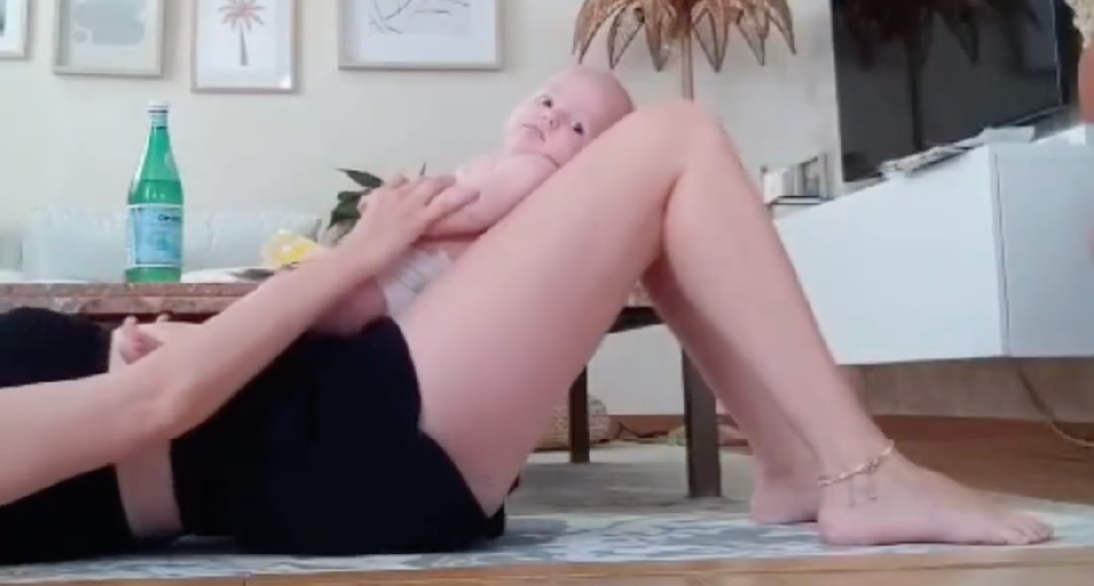In our latest article, we’re going to talk about two topics we get asked about regularly by new moms. Firstly, breastfeeding and diastasis recti. And secondly, the effect of postpartum nutrition on diastasis recti.
There’s a lot out there on the internet about what to do or not do when you have diastasis recti or pelvic floor dysfunction. Typically, it’s about exercise, like doing core workouts or if pilates is okay when you have diastasis. Those things are important to understanding your options around restoring core health after birth, but they’re not the only ways to heal.
Alignment — or posture — is often overlooked when talking about diastasis recti. It’s so important, though! That also means considering alignment while feeding your newborn.
Postpartum nutrition is another topic left out of many conversations around diastasis recti. How you nourish yourself is important for any recovery process. It’s also incredibly important to think about in postpartum and beyond.
So, let’s dive into these two topics.
Breastfeeding and Diastasis Recti: How do Breastfeeding Positions Help or Worsen Diastasis Recti?
Our apologies in advance for throwing another position to think about during breastfeeding, but how you position yourself can be just as important as how you position your baby during feeds.
For many reasons, infant feeding positions which have you rounding your shoulders and leaning over baby are going to put extra strain on your body. This is true for your core, pelvic floor muscles and abdominal muscles too. Having a squashed tummy and strained back is the opposite of what you want when trying to heal diastasis recti. Not to mention it’s not that great for your wrists or baby’s latch either.
Instead, try positioning your body so that you’re reclining at a 45° angle (if seated). You shouldn’t feel a tug on your back muscles. The bonus to this position, besides just being better for your core, is that baby can bob around on your chest and get a more “natural” latch and you’ll likely need fewer pillows and props, making it easier to feed anywhere and in a shorter period of time. An all-around win!
For anyone bottle feeding who has diastasis recti, you can take a look at how you’re positioned during feeds, too. Try not to hunch your shoulders way over while feeding. Instead, you may want to find a place to feed where you can sit up very straight and prop baby up higher. This can make it easier on your core, while making it easier to practice the preferred “paced feeding” method of bottle feeding, too.
The Role of Proper Nutrition in Postpartum Recovery and Healing Diastasis Recti
Postpartum nutrition is important for everyone, regardless of having diastasis recti. However, though diastasis isn’t an injury, it still will take some extra work for your body to heal from. When your body is asked to do more for itself, it’s essential to fuel it well.
This doesn’t mean you have to go out and buy a ton of supplements or superfoods, either. You can find the right building blocks for healing diastasis recti in many common foods.
Here are a few important nutrients for postpartum health and where to find them:
- Collagen: Skin, bones, tendons, and ligaments of beef, chicken, fish, and pork. Bone broth is a great source of collagen.
- Vitamin C: Kiwi, bell peppers, green leafy veggies, citrus. (Pssst…Vitamin C is necessary for your body to produce and absorb collagen!)
- Vitamin E: Green beans, sunflower seeds, pumpkin, olive and sunflower oil.
- Protein: Meat and dairy, tofu, beans, lentils, eggs, grains.
- Fiber: Fruit and veg, avocados, whole grains, beans.
- Bioflavonoids: Parsley, citrus, peppers, brussels sprouts.
Nutrients like fiber and bioflavonoids and even the prebiotics that help feed the healthy bacteria in your body are found in the bits of fruits and veggies we normally toss away. Making a vegetarian broth with scraps and leaving a bit of the pith (the connective bits — often white — that may hold together seeds or a peel) stalk, and skin on while you munch.
Learn more in this article with Postpartum Nutritionist Jessica Drummond.
What about postpartum hydration?
Your body will use a great deal of water in producing your breast milk supply. Even if you don’t feed your baby from your body, you will be shedding a lot of fluids as your body recovers from birthing. In all cases, this may lead to one of the errrr….crappier sides of dehydration — constipation.
Hard stools and/or constipation can lead to a lot of straining on the loo, which can slow or stall diastasis recti and pelvic floor healing. This is true whether you just had a baby, or if you are trying to heal your diastasis recti many years later.
Make sure you’re drinking water often in postpartum, especially if you are breastfeeding. If you feel like you’re thirsty often and having problems passing stool, try mixing in drinks with electrolytes like coconut water or low-sugar electrolyte tabs.
Don’t Slouch and Eat Your Veggies!
Looks like some typical grandmotherly advice can be helpful for new mums.
Proper nutrition by eating a diet rich in colorful foods, fresh fruit and veggies, and a balance of meat and grains can be a huge boost to your postpartum health. That doesn’t mean forgo some easy meals and comfort food — all times of rest and healing should make room for foods which warm our hearts and fill our bodies, too.
In our latest article, we’re going to talk about two topics we get asked about regularly by new moms. Firstly, breastfeeding and diastasis recti. And secondly, the effect of postpartum nutrition on diastasis recti.
There’s a lot out there on the internet about what to do or not do when you have diastasis recti or pelvic floor dysfunction. Typically, it’s about exercise, like doing core workouts or if pilates is okay when you have diastasis. Those things are important to understanding your options around restoring core health after birth, but they’re not the only ways to heal.
Alignment — or posture — is often overlooked when talking about diastasis recti. It’s so important, though! That also means considering alignment while feeding your newborn.
Postpartum nutrition is another topic left out of many conversations around diastasis recti. How you nourish yourself is important for any recovery process. It’s also incredibly important to think about in postpartum and beyond.
So, let’s dive into these two topics.
Breastfeeding and Diastasis Recti: How do Breastfeeding Positions Help or Worsen Diastasis Recti?
Our apologies in advance for throwing another position to think about during breastfeeding, but how you position yourself can be just as important as how you position your baby during feeds.
For many reasons, infant feeding positions which have you rounding your shoulders and leaning over baby are going to put extra strain on your body. This is true for your core, pelvic floor muscles and abdominal muscles too. Having a squashed tummy and strained back is the opposite of what you want when trying to heal diastasis recti. Not to mention it’s not that great for your wrists or baby’s latch either.
Instead, try positioning your body so that you’re reclining at a 45° angle (if seated). You shouldn’t feel a tug on your back muscles. The bonus to this position, besides just being better for your core, is that baby can bob around on your chest and get a more “natural” latch and you’ll likely need fewer pillows and props, making it easier to feed anywhere and in a shorter period of time. An all-around win!
For anyone bottle feeding who has diastasis recti, you can take a look at how you’re positioned during feeds, too. Try not to hunch your shoulders way over while feeding. Instead, you may want to find a place to feed where you can sit up very straight and prop baby up higher. This can make it easier on your core, while making it easier to practice the preferred “paced feeding” method of bottle feeding, too.
The Role of Proper Nutrition in Postpartum Recovery and Healing Diastasis Recti
Postpartum nutrition is important for everyone, regardless of having diastasis recti. However, though diastasis isn’t an injury, it still will take some extra work for your body to heal from. When your body is asked to do more for itself, it’s essential to fuel it well.
This doesn’t mean you have to go out and buy a ton of supplements or superfoods, either. You can find the right building blocks for healing diastasis recti in many common foods.
Here are a few important nutrients for postpartum health and where to find them:
- Collagen: Skin, bones, tendons, and ligaments of beef, chicken, fish, and pork. Bone broth is a great source of collagen.
- Vitamin C: Kiwi, bell peppers, green leafy veggies, citrus. (Pssst…Vitamin C is necessary for your body to produce and absorb collagen!)
- Vitamin E: Green beans, sunflower seeds, pumpkin, olive and sunflower oil.
- Protein: Meat and dairy, tofu, beans, lentils, eggs, grains.
- Fiber: Fruit and veg, avocados, whole grains, beans.
- Bioflavonoids: Parsley, citrus, peppers, brussels sprouts.
Nutrients like fiber and bioflavonoids and even the prebiotics that help feed the healthy bacteria in your body are found in the bits of fruits and veggies we normally toss away. Making a vegetarian broth with scraps and leaving a bit of the pith (the connective bits — often white — that may hold together seeds or a peel) stalk, and skin on while you munch.
Learn more in this article with Postpartum Nutritionist Jessica Drummond.
What about postpartum hydration?
Your body will use a great deal of water in producing your breast milk supply. Even if you don’t feed your baby from your body, you will be shedding a lot of fluids as your body recovers from birthing. In all cases, this may lead to one of the errrr….crappier sides of dehydration — constipation.
Hard stools and/or constipation can lead to a lot of straining on the loo, which can slow or stall diastasis recti and pelvic floor healing. This is true whether you just had a baby, or if you are trying to heal your diastasis recti many years later.
Make sure you’re drinking water often in postpartum, especially if you are breastfeeding. If you feel like you’re thirsty often and having problems passing stool, try mixing in drinks with electrolytes like coconut water or low-sugar electrolyte tabs.
Don’t Slouch and Eat Your Veggies!
Looks like some typical grandmotherly advice can be helpful for new mums.
Proper nutrition by eating a diet rich in colorful foods, fresh fruit and veggies, and a balance of meat and grains can be a huge boost to your postpartum health. That doesn’t mean forgo some easy meals and comfort food — all times of rest and healing should make room for foods which warm our hearts and fill our bodies, too.











